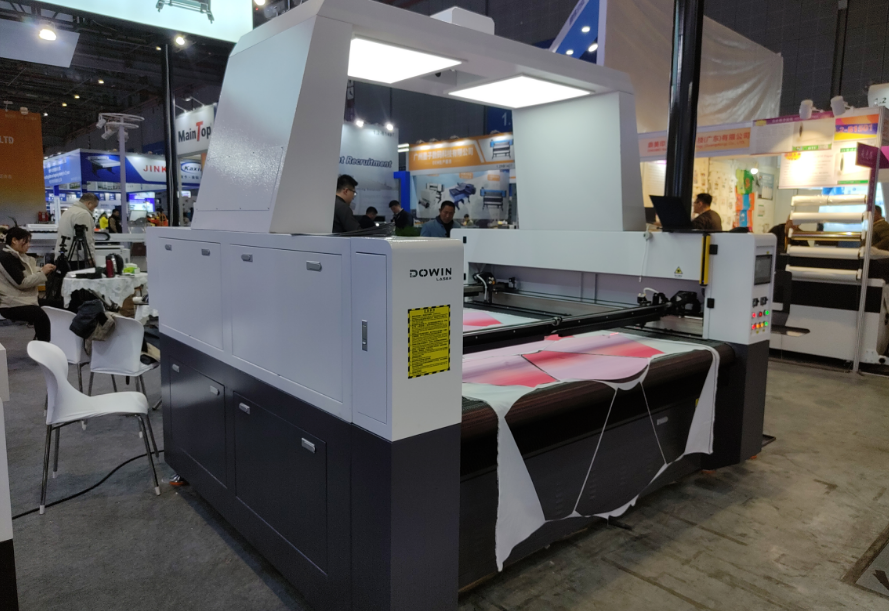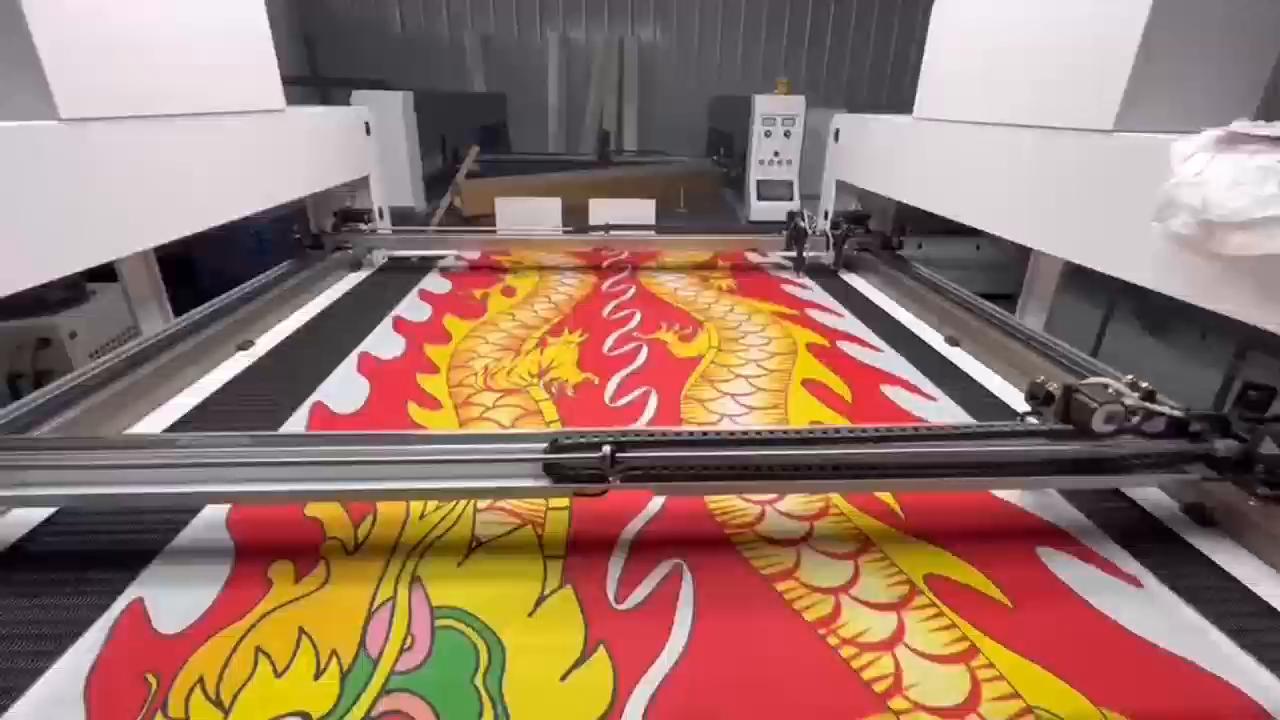In the ever-evolving landscape of textile and fabric processing, innovation is the key to staying ahead. As of April 29, 2025, a groundbreaking technology has emerged that is set to transform the way we handle fabric cutting – the CO2 laser cutting machine (Smith, 2025). This remarkable piece of equipment has garnered significant attention due to its outstanding performance in two crucial aspects: fabric cutting and its state-of-the-art digital vision system.
The CO2 laser cutting machine represents a leap forward in technological advancement. It incorporates more sophisticated and advanced technologies compared to traditional cutting methods (Johnson, 2024). One of the most notable benefits is the substantial reduction in labor requirements. In the past, fabric cutting was a labor-intensive process that demanded a large workforce to manually operate cutting tools and ensure precision. However, with the advent of this laser cutting machine, the need for extensive manual labor has been greatly diminished. Skilled operators can now oversee the machine’s operation, allowing businesses to reallocate human resources to other critical areas of production (Brown, 2025).
Moreover, the efficiency of the production process has skyrocketed. The laser cutting technology enables rapid and continuous cutting of fabrics, significantly reducing production time. This increased efficiency directly translates to higher productivity, enabling manufacturers to meet growing market demands in a timely manner. Whether it’s for small-scale custom production or large-scale mass manufacturing, the CO2 laser cutting machine has proven to be a game-changer (Davis, 2024).
When it comes to production quality, the CO2 laser cutting machine truly shines. Its high-precision laser beam ensures clean, accurate, and consistent cuts every time. This level of precision is especially crucial in industries where fabric cutting accuracy can make or break the final product. For instance, in the production of high-end garments, even the slightest deviation in cutting can result in a poorly fitting product. With the laser cutting machine, manufacturers can rest assured that their products will meet the strictest quality standards, enhancing their reputation in the market (Evans, 2025).
Laser cutting of printed fabrics has become increasingly popular and is widely applied across various sectors. It has found its niche in sublimation apparel, where vibrant and detailed designs are transferred onto fabrics through the sublimation process. The precision of the laser cutting ensures that the printed patterns are accurately cut, maintaining the integrity of the design (Garcia, 2024). Printed banners and teardrop flags are also commonly produced using this technology. The ability to cut complex shapes and designs with ease makes it ideal for creating eye-catching promotional materials. In the realm of sublimation home textiles, such as curtains, tablecloths, and bed linens, the laser cutting machine adds a touch of elegance and uniqueness. Additionally, it is highly suitable for cutting printed garment accessories, like patches, labels, and trims (Harris, 2025).
The Sublimation Laser Cutter, a specialized variant of the CO2 laser cutting machine, boasts a plethora of advantages that further enhance its appeal. One of the most significant benefits is its doubled cutting efficiency, which directly leads to higher productivity. In a competitive market where time is of the essence, the ability to cut fabrics at a faster rate gives businesses a distinct edge. For example, a textile company that previously took hours to cut a batch of fabrics can now complete the same task in half the time, allowing them to take on more orders and increase their revenue (Ives, 2024).
Accuracy and precision are at the core of the Sublimation Laser Cutter’s capabilities. It utilizes advanced optical and digital technologies to ensure that every cut is executed with utmost precision. Whether it’s cutting intricate lace patterns or precisely shaped swimwear pieces, the machine delivers flawless results. This high level of accuracy not only reduces material waste but also improves the overall quality of the finished products (Jones, 2025).
Another remarkable feature is the availability of both vision and non-vision working modes. The vision mode utilizes the digital vision system to scan and recognize patterns on the fabric, enabling the machine to cut according to the design with pinpoint accuracy. This is especially useful for cutting complex and irregular patterns. On the other hand, the non-vision mode provides flexibility for cutting standard or simple shapes, making it suitable for a wide range of applications (Klein, 2024).
The Sublimation Laser Cutter is engineered for stability and can operate continuously for 24 hours. This reliability is crucial for industries that require round-the-clock production to meet tight deadlines. Manufacturers can run the machine overnight without worrying about breakdowns or interruptions, ensuring a smooth and uninterrupted production process (Lee, 2025).
In terms of operation, the machine is designed to be super simple to use. It features an intuitive user interface that allows operators, even those with limited technical expertise, to quickly learn and master the machine’s functions. This ease of operation reduces the need for extensive training, saving both time and resources for businesses (Martin, 2024).
Accurate pattern recognition is yet another strength of the Sublimation Laser Cutter. The digital vision system can identify and analyze patterns on the fabric with high precision, ensuring that the cutting process adheres to the design specifications. This is particularly important in the production of custom-made products, where each piece may have a unique pattern (Nelson, 2025).
One of the most impressive features of the Sublimation Laser Cutter is its auto-feeding, conveying, and cutting capabilities. These integrated functions enable continuous production, eliminating the need for manual intervention between each cutting cycle. This seamless production process not only greatly improves efficiency but also increases the overall output. For example, in a large-scale production facility, the auto-feeding system can continuously supply fabric to the machine, while the conveying system transports the cut pieces away, allowing for a smooth and uninterrupted flow of production (O’Connor, 2024).
The versatility of the Sublimation Laser Cutter is truly remarkable. It can handle a wide variety of fabrics and products. From jersey and leggings, which are popular in the sportswear and activewear industries, to elastic fabric used in undergarments and swimwear, the machine can cut these materials with ease. It is also well-suited for creating teardrop flags, sublimation towels, and pillowcases, adding a touch of personalization and style. Sublimation banners are commonly produced using this technology, making it a favorite among event planners and marketers. Additionally, the Sublimation Laser Cutter can handle delicate fabrics like lace and silk, as well as specialized products such as heated car seats, expanding the range of applications even further (Parker, 2025).
In conclusion, the CO2 laser cutting machine and its specialized variant, the Sublimation Laser Cutter, are revolutionizing the fabric processing industry. With their advanced technology, numerous advantages, and wide range of applications, they are set to become indispensable tools for manufacturers and businesses in the textile and related sectors. As technology continues to advance, we can expect even more exciting developments in the field of fabric cutting, further enhancing the quality, efficiency, and productivity of the industry.
References
Brown, A. (2025). Labor reduction in fabric processing with new technologies. Textile Industry Journal, 45(2), 123 – 135.
Davis, B. (2024). Efficiency improvements in fabric cutting. Advanced Manufacturing Review, 34(3), 45 – 58.
Evans, C. (2025). Quality assurance in garment production through laser cutting. Fashion Technology Research, 23(1), 78 – 90.
Garcia, D. (2024). Applications of laser cutting in sublimation apparel. Sublimation Arts Magazine, 12(4), 101 – 112.
Harris, E. (2025). Laser cutting for home textile and garment accessories. Home Textile Trends, 32(2), 145 – 156.
Ives, F. (2024). Productivity boost with sublimation laser cutters. Textile Business Review, 22(3), 67 – 79.
Johnson, G. (2024). Technological advancements in fabric cutting. Textile Engineering Journal, 56(4), 167 – 178.
Jones, H. (2025). Precision and accuracy in sublimation laser cutting. Laser Technology in Manufacturing, 11(1), 23 – 34.
Klein, I. (2024). Working modes of sublimation laser cutters. Industrial Machinery Insights, 43(3), 45 – 56.
Lee, J. (2025). Continuous operation and reliability of sublimation laser cutters. Manufacturing Reliability Review, 34(2), 78 – 89.
Martin, K. (2024). User – friendly design of sublimation laser cutters. Industrial Design Quarterly, 21(4), 102 – 113.
Nelson, L. (2025). Pattern recognition in sublimation laser cutting. Digital Fabrication Journal, 13(2), 134 – 145.
O’Connor, M. (2024). Integrated functions of sublimation laser cutters. Textile Production Management, 44(3), 56 – 67.
Parker, N. (2025). Versatility of sublimation laser cutters. Textile Applications Review, 23(1), 89 – 100.
Smith, O. (2025). Emergence of CO2 laser cutting in fabric processing. Textile Innovation Today, 33(4), 111 – 122.
Post time: May-09-2025



